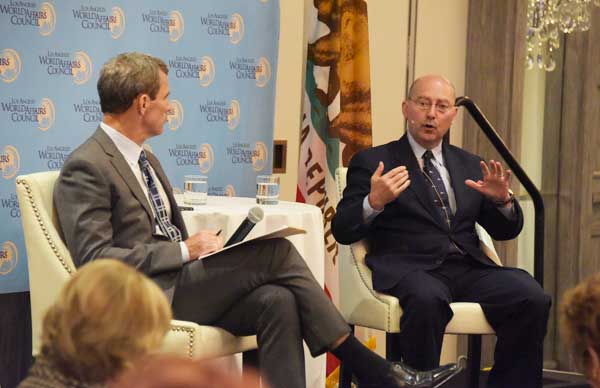
LAWAC President Terry McCarthy with Admiral Stavridis (right)
China is being “completely disingenuous” in its supposed efforts to help contain North Korea’s nuclear program, and needs to do much more so the US is not forced to take on Pyongyang on its own, which could lead to war, according to Admiral James Stavridis, a 35 year-veteran of the US Navy. “The Chinese are not walking the walk…they control 90% of the commerce that goes in and out of North Korea,” said Stavridis. Talking at a LAWAC dinner on June 22nd, the former NATO Supreme Commander said that now that China told President Trump they have not been able to put pressure on North Korea, the US should step up its missile defense deployments around North Korea, coordinate more closely with our allies in East Asia, intensify our cyber campaign to disrupt Pyongyang’s missile system and then go back to China and lean heavily on them, using trade deals with Beijing as leverage.
Stavridis says it is reasonable to go back to the negotiating table, and if we cannot achieve a roll-back of Pyongyang’s nuclear program, at least a freeze on their current development projects could prevent the current show-down from escalating. “What would it look like if we got into a war with North Korea? In one word: Bad.” He said there is an 80% chance of some form of negotiated outcome, but with a non-trivial 20% chance of military conflict. This would likely involve three or four US aircraft carrier battle groups, long range US bombers from Guam and substantial cooperation from Japan – an eventuality that would lead to enormous loss of life and destruction. We have about 18 months to negotiate some form of agreement, said Stavridis, because by that time the North Koreans will have developed long-range ICBMs that could hit Los Angeles. They also will have miniaturized their nuclear warheads to fit them onto the missiles. “I think we’re verging to the point that under international law, you could justify a preemptive strike.”
The South China Sea is the area where a confrontation between the US Navy and the Chinese is most likely, he said. The confrontation is likely to come from some form of a collision or push-back “that will involve steel on steel” with a US vessel because the US Navy will not allow the Chinese to intimidate them from carrying out freedom of navigation patrols. However, he does not predict a US-China war, which is in neither side’s interests, and said that one of the biggest questions in international relations is how we find “a confluence of interests” with China.
In the longer view of history, Stavridis predicted that the big story of the 21st century will not be the rise of China, but the rise of India. “Demographics are destiny, and India is young.” In the short term he said India will have a bumpy road, “but twenty years out, that road starts to smooth.” China, by contrast, appears to have a smooth road now, but “it will get bumpier because they’re aging rapidly, overbuilding, they have enormous environmental damage and overall, because they’re not a democracy. India has a safety valve, China does not.”
The Russian Navy, which he said is easily the second strongest navy in the world, is a cause for concern. “The Russian Navy at the end of the Cold War was largely broken up. Over the last ten years, they’ve built it back up. Putin is very focused on this. They are aggressively building. They are challenging us in the Arctic, Mediterranean, the Baltic Sea, even in the Pacific. Russia is rising. Today, they are 60 or 70% as capable as the US Navy.” In the next three years, Stavridis says the Russians will add another 100 ships to their fleet – one of the reasons why he supports a build-up of the US fleet from its current level of 275 ships to a target of 350.
Asked whether the US Navy’s aircraft carriers risk being made obsolete by the development of anti-carrier missiles, particularly by the Chinese, Stavridis pointed out that in the run-up to Japan’s attack in 1941 it was the battleships that the US regarded as the pride of the fleet. But when they were largely destroyed in Pearl Harbor by aircraft from Japanese carriers – while the US aircraft carriers were fortuitously out to sea and not damaged – the US Navy began to realize the value of its own carriers. “So are our carriers of today like the battleships of the 1940’s?” He said that he did not think so – yet. He said that for the time being our missile defenses and electronic countermeasures to protect against the Chinese missiles are adequate. “Could this shift over the next 20 years? Yes… but for the moment the carriers remain the centerpiece.”
